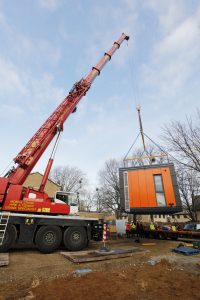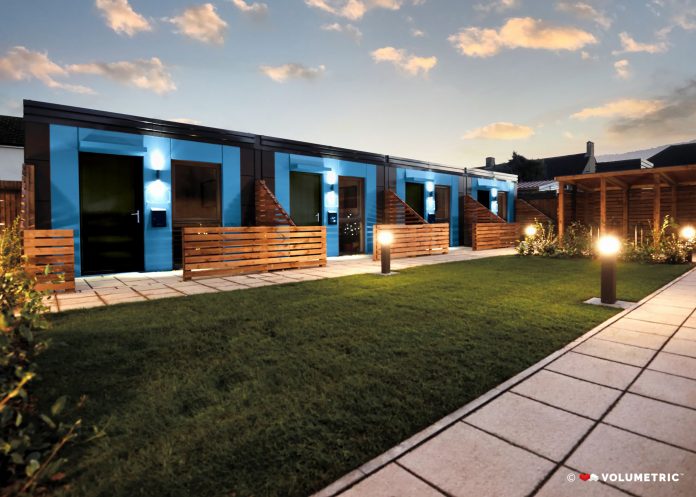The Future Homes Standard will bring about fundamental changes as the UK looks to “futureproof” its housing stock. Trevor Richards, operations director of Volumetric, a specialist in volumetric modular housing solutions, outlines the challenges involved and makes a case for expedient action
A lot has happened since January 2021 when the government published the outcome of the Future Homes Standard consultation and therefore it may not be front of mind. But the details outlined are not a set of abstract requirements that may or may not come into force – changes are imminent and now is the time to consider what is coming down the track.
The Future Homes Standard outlines changes to Building Regulations Part L (conservation of fuel and power) and Part F (ventilation) that will ultimately come into effect in 2025 to ensure that all new homes in England are futureproofed with low-carbon heating systems and high levels of energy efficiency. These standards should ensure that all new homes will produce 75%-80% less carbon emissions than houses delivered under current regulations.
As an interim step, announcements surrounding changes to Part L are expected to come into force to ensure new homes built from 2022 will produce 31% less carbon emissions. Full technical specification for the Future Homes Standard will be consulted on in 2023, with the necessary legislation introduced ahead of implementation in 2025. So, change is happening and happening at pace.
Adopting a partnership approach
Here at Volumetric, we adopt a partnership approach and have worked in close collaboration with Foundation200, an initiative established by housing developer Hill Group to gift 200 interim homes for rough sleepers to homeless charities and local authorities to mark the company’s 20th anniversary. The team behind Foundation200 required specialist support to design and manufacture a bespoke solution – Modulhaus – was the outcome of much research and an extensive testing and certification regime.
Right from the initial concept stages, the decision was reached to develop a modular solution that would exceed the Future Homes Standard to relieve the burden on local authorities of ongoing expenses associated with traditional temporary accommodation and negate fuel poverty.
Striking a balance
As ever, the devil is in the detailing and there is a lot more to achieving the Future Homes Standard than we initially considered. Not willing to compromise on our client’s expected performance for the intended application, our team modelled and remodelled our designs, with countless materials and technologies assessed and evaluated to ensure we achieved our optimum position.
Achieving the right balance was challenging. Sometimes the benefits of one solution counteract the benefits of another, making you feel like it was one step forward and one back. Whether it is insulating the lightweight structure to ensure the best envelope was attained, while arresting any potential overheating that the relative lack of thermal mass in the same lightweight structure brings or understanding which renewable technologies to use given the variability of potential site locations and restrictions. It was essential that we invested time up front to resolve these issues and to find the optimum balance.
Modulhaus
The embodied carbon assessment for Modulhaus has been undertaken based on RICS and British Standard guidance. This includes information from relevant Environmental Product Declarations (EPDs), publicly available carbon data and in comparison, with an equivalent timber frame structure over the whole life of the building (60 years). The Modulhaus system shows an 18% improvement in carbon performance.
At all stages of the Modulhaus system development these criteria have been assessed for the forecast 60-year whole-life embodied carbon, along with system energy use and full SAP calculations. This analysis has also considered “cradle to factory gate” raw material extraction, transport and processing into product, “construction” processes and in-use raw material extraction maintenance. We are currently also assessing the potential for carbon offsetting or balancing to achieve our zero-carbon target by the beginning of 2022.
The futureproof energy strategy for Modulhaus is designed to exceed the Future Homes Standard with Environment Band A rating and emissions as low as 229.5KG CO2/year. Modules are factory fitted with sustainable technologies, low energy lighting and white goods together with controlled flow shower mixers and dual flush cisterns to minimise energy and water consumption.
Renewable energy technology is built into every module, including air source heat pumps (ASHP) and mechanical ventilation and heat recovery (MVHR) systems. Combined with a highly airtight and well insulated structure, U-values as low as 0.09W/m2K are provided.
In addition, the airtightness achieved in using a volumetric modular approach enhances in-use energy efficiency and reduces carbon emissions for the lifetime of the building. Results of 3m3/hr/m2 air loss at a 50 Pa are being routinely achieved during factory testing as part of our QA procedures.
This has been a massive learning curve and reaching the Future Homes Standard is simply not just a case of adding more insulation. It is far more complex than that. So, although 2025 may seem a way off, after experiencing the challenges involved first-hand, it is better to take time now and get your design and testing protocols right, than taking a risk and failing to meet the complexities involved.
A rapid and affordable solution to the homeless crisis
To meet the needs of local authorities battling to find a cost-effective solution to address rough sleeping, the Modulhaus single person interim housing solution has been developed and launched after a rigorous 18-month research and development programme.
After picking up the award for Building Performance Pioneer at the recent Offsite Awards, the judge’s decision was unanimous and Modulhaus was also crowned the ultimate “Winner of Winners”.
Reducing ongoing energy costs to less than £5 per week, this solution provides greater dignity and independence to the most vulnerable members of society while also relieving the burden on local authorities of ongoing expenses associated with traditional temporary accommodation.
Modulhaus design features:
- BOPAS-certified structure with 60-year design life.
- LABC Assured Building Control approval.
- Fully non-combustible, fire tested to exceed Building Regulations.
- Robust and thermally efficient.
- Galvanised steel external walls and double lined internal walls.
- Renewable energy technology via a shared energy centre.
- External air source heat pump.
- Mechanical ventilation and heat recovery.
- Stackable to two storeys with a range of cladding colours.
- Installed on just six low impact foundation pads to minimise groundworks.
- Relocatable with over 95% material recoverability and re-use.
Trevor Richards
Operations director
Tel: +44 1743 290020

















